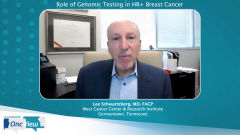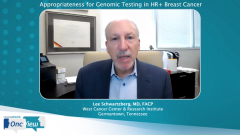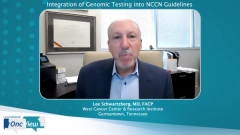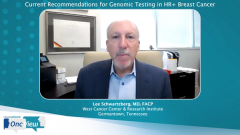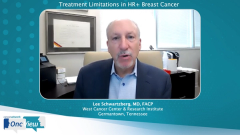
Molecular Biomarkers for HR+ Breast Cancer
An overview of predictive and prognostic biomarkers used by breast oncologists to aid in adjuvant treatment decisions for HR-positive disease, as outlined by the NCCN guidelines.
Episodes in this series

Kristie Kahl: Absolutely. What are the predictive and prognostic factors that you use to guide treatment selection as an outline in the NCCN [National Comprehensive Cancer Network] guidelines?
Lee Schwartzberg, MD, FACP: The factors we use to determine what kind of adjuvant therapy patients should receive are based on combination of clinical factors or so-called anatomical factors, patient-related factors, and tumor-related factors. That is the biology of the tumor. In terms of the clinical factors and the anatomical factors, that relates to the size of the tumor whether it’s very small, or T1 lesion, or T1a and T1b lesion, which we consider very small. Less than 1 centimeter [cm]. T1c, 1 cm to 2 cm. T2, 2 cm to 5 cm. T3. And as the size of the tumor goes up, the risk goes up. Very importantly, the nodal status is an indicator or prognosis. With no nodes being better than any nodes positive. And essentially, an incremental risk that goes up with the number of nodes that are positive. We also look at the grade of the tumor. That’s a very important aspect of prognosis that sometimes is forgotten. There is some variation among pathologists about grade which is why it’s a bit difficult to standardize. But clearly, patients who have grade 3 tumors, which is the highest grade, or undifferentiated cancers have a much higher risk than those that have low-grade tumors. The grading is 1, 2, or 3. Low-intermediate and high risk. The biologic factors that we look at include the biomarkers that are essential for every breast cancer to have recorded. That includes estrogen receptor, progesterone receptor, and HER2. Estrogen receptor and progesterone receptor positivity make the cancer hormone receptor-positive, and therefore potentially hormone sensitive. By blocking estrogen either by blocking it competitively with a drug like Tamoxifen or in women whose ovaries are no longer functioning, by blocking the production of the small amount of estrogen that is made in other tissues through conversion of other factors. Through aromatase. We can use an aromatase inhibitor to block essentially almost all estrogen from being made. That basically is a growth signal and a signal to keep cancer cells alive. That little bit of estrogen can do that. An aromatase inhibitor can work very well in patients who are postmenopausal. In fact, in the early trials when compared with Tamoxifen, they were better than Tamoxifen. In postmenopausal women, aromatase inhibitors are the standard of care for adjuvant endocrine therapy.
Transcript edited for clarity.
Newsletter
Stay up to date on recent advances in the multidisciplinary approach to cancer.


